
Newsletter
- [ Vol. 1 No. 1 ]
(January - April 2000 ) - [ Vol. 1 No. 2 ]
(May - August 2000 ) - [ Vol. 1 No. 3 ]
(September - December 2000 ) - [ Vol. 2 No. 1 ]
(January - April 2001 ) - [ Vol. 2 No. 2 ]
(May - August 2001 ) - [ Vol. 2 No. 3 ]
(September - December 2001 ) - [ Vol. 3 No. 1 ]
(January - April 2002 )
 1 of 5
1 of 5

Newsletter
[ Vol. 6 No. 1 ] (January - April 2005 )
Tsunami
Tsunami
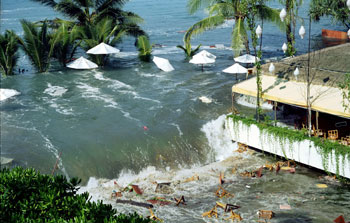
Dear Editor;
The greatest tragedy in Asian history in this decade occurred on December 26th, 2004. The magnitude 9.3 earthquake occurred off the west coast of northern Sumatra, Indonesia. This second-largest earthquake in the world since 1900 generated more than 10 meter-high tsunami which swept across the Indian Ocean within hours and devastated the shore of Indonesia, Thailand, Sri Lanka, India and other countries in Asia and Africa. Anywhere from 280,000 to 310,000 people are thought to have died as a result of the tsunami, with tens of thousands reported missing, and over a million left homeless.
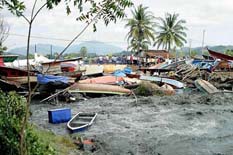
In Thailand the tsunami attack was along the coast line of Satool, Trang, Krabi, Phuket and Ranong and the worst place - Phang-nga. Tsunami devastated both local fishermen villages and tourist-filled 5-star hotels and resorts. The boats were swept as far as 2 kilometers into the land. Five thousand people died and more than ten thousand injured and needed prompt treatment. Seventeen doctors and nurses from Siriraj Hospital and 9 from Ramathibodi Hospital volunteered to help the local doctors in managing the mass casualty and I was one in the team. We arrived Phuket on December 27th, 2004 afternoon (36 hours after injury) and were assigned to work at Takuapa District Hospital. This hospital has about 200 beds with 30 doctors, one of which lost her life in the event as well. When we arrived, the hospital was packed with more than 500 injured patients. They had to share a bed, laid on the floor and filled up even in the conference room and over flown to the yard nearby. We separated our team into 2 groups. One group went directly to the operating room and the other made a round through all the patients to classify them according to the severity of injury and necessity of treatment. The patients can be classified as which:
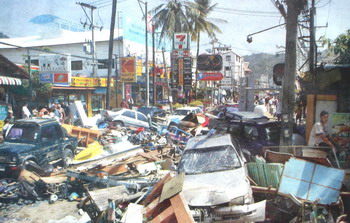
Class A: Resuscitation-required group: There were 10-15 patients in this group and at that time, they were already transferred to intensive care unit. The examples of patients in this group were near drowning patients, ones with aspiration pneumonia and/or sepsis.
Class B: Severely injured group: About a hundred cases were classified into this group such as patients with multiple fractures, pneumothorax, hemothorax, cellulitis and fasciitis.
Class C: Patients with minor injuries: There were more than 300 cases that had soft tissue injuries, punctured wounds, lacerated wounds and/or abrasion wounds.
Class D: Dead bodies: About thousands bodies were sent to Yan Yao and Bang Muang Temples.
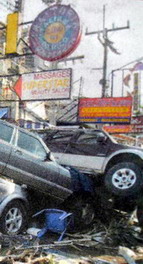
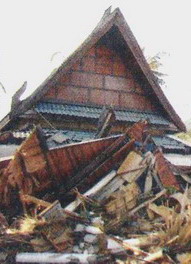
The problems we found were the inappropriate wound caring due to the nature of the injury themselves and lack of amount and experiences of medical personnel during the first few hours. The special characteristic of wounds of the tsunami survivors are soft tissue injuries by blunt objects which were exposed to sea-water and were severely contaminated. Sands, mud, stones and other foreign bodies were forced deeply into the wounds and rapidly turn them into deep tissue infection and fasciitis within one day. Thus when we arrived, the lacerated wounds which received primary suture, puncture wounds which did not receive adequate irrigation and debridement and even the deep abrasive wounds had turned out to be infected with foul-smell pus and many patients who used to be in class C were turned to class B and A.

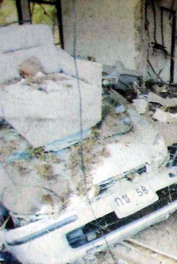
The emergency plan of our team was:
- To screen the high risk patients
- To operate these high risk patients for appropriate wound care. (which was expected that we had to work for the whole night)
- To transfer the foreigners to other hospitals in Bangkok which had better facilities and could provide better care than Takuapa Hospital in that situation. Thus, we might be able to accommodate more cases with better quality of care.
Within 36 hours that our team had worked there, we operated 130 cases and transferred more than 70 cases to Bangkok and the hospitals nearby. Most of the operations were drainage, irrigation and debridement and appropriate antibiotics were also prescribed.
In transferring the patients, we needed more than 20 ambulances from the nearby provinces and air-lift helicopters were provided by both commercial and Royal Air Force's planes. After the mission was complete, the hospital seemed to be in much better situation. The numbers of patients were proper for the facilities available and the personnel had more time to provide quality care.
Our team had handed over the job to other teams from the Ministry of Health and returned back to Bangkok on December 29th, 2004. Our Hospital also sent 2-3 teams of Forensic Medicine specialists and personnel to work at Bang Muang Temple to identify the corpses and teams of psychiatrists to help the survivors during the following days.
Takuapa Hospital and our team would like to thank for the donation and contribution from many people and organizations. What we received that made a lot of help were : disposable operating kits, disposable operating gloves and gowns, endotracheal tubes and other medical equipments, antibiotics, antiseptics, food, clean water, ambulances and even air-lift helicopters for the referring operation.
Soranit Siltharm, M.D.
Secretary of PENSA Center, Thailand


